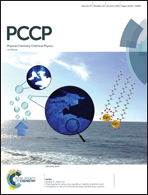Synergistic host–guest hydrophobic and hydrogen bonding interactions in the complexation between endo-functionalized molecular tube and strongly hydrophilic guest molecules in aqueous solution†
Abstract
The propensity of complex formation of a host, an endo-functionalized naphthotube that has bisnaphthalene cleft architecture (host-1b), with four different strongly neutral hydrophilic guest molecules, namely 1,4-dioxane (14D), acetone, DMSO and DMF, in water is examined using classical molecular dynamics simulations. This type of molecular tube has received significant attention recently due to its usefulness as a supramolecular catalyst and for its ability to selectively recognise biologically and environmentally important neutral molecules in aqueous solution. We sequentially address the role of the different guest molecules in the structural change of host-1b, the role of the host–inserted guest and the water–inserted guest hydrogen bond properties and the host–guest binding free energies in the complex. The derivatives of our findings are: (a) the host changes its shape upon the insertion of a guest molecule and the magnitude of the shape change depends on the type and the nature of the guest molecule; (b) the complete insertion of a guest into the cavity of host-1b is only observed for guest 14D; and (c) the complete removal of water molecules from the host cavity is observed for guest 14D and the presence of a single water molecule is observed for all other guest molecules. The PMF and MM-PBSA calculations reveal that host-1b/14D complexation is the most energetically stable and the synergistic host–guest hydrophobic and hydrogen bonding interactions play a profound role in the stability of these host–guest complexes. Specifically, as the host cavity contains a small hydrophilic part and a large hydrophobic part, guest molecules with both these parts can form hydrogen bonds with the hydrophilic part of the host as well as forming a favorable hydrophobic interaction with the hydrophobic part of the host at the time of complexation.



 Please wait while we load your content...
Please wait while we load your content...